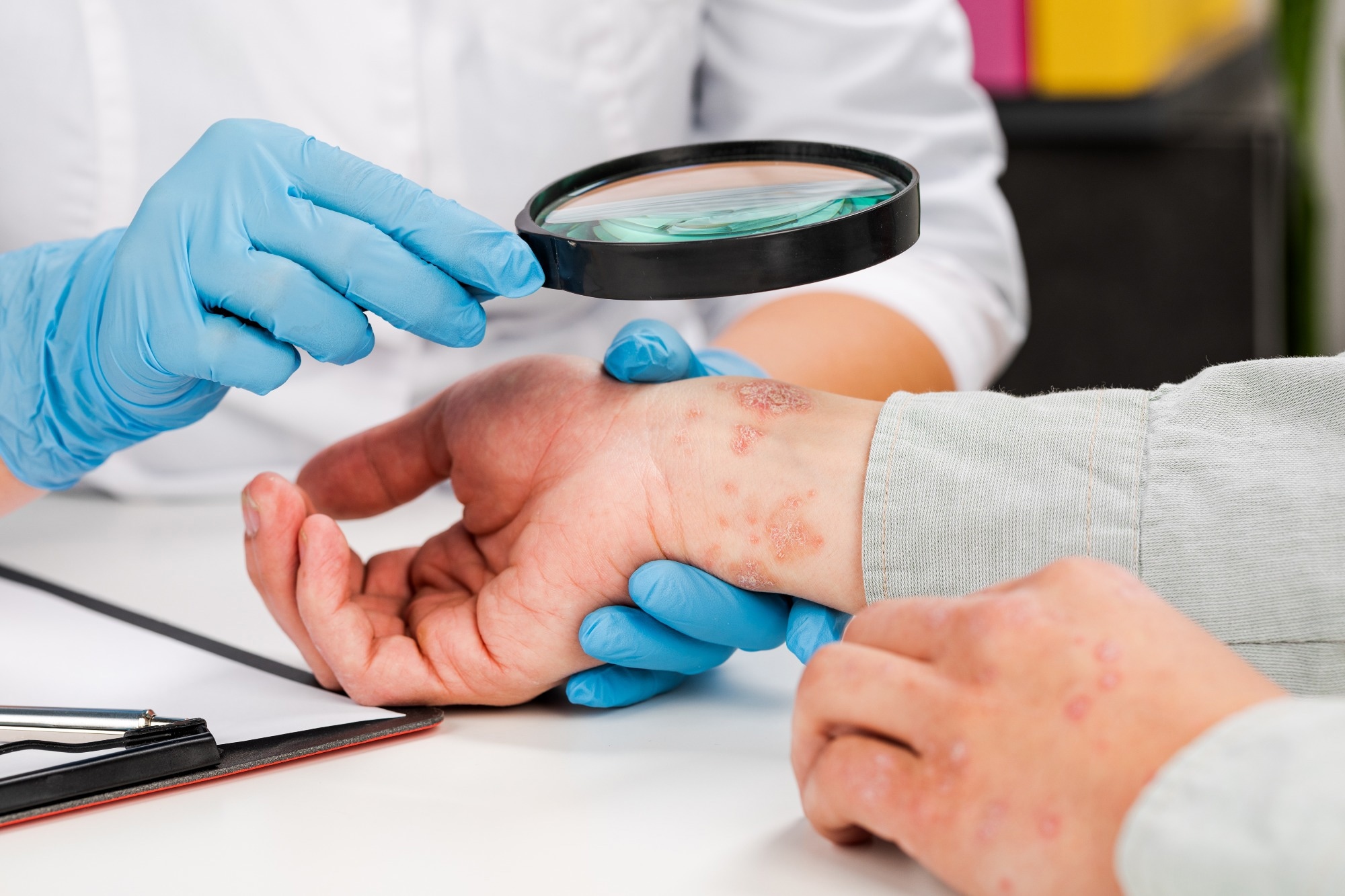In a recent study published in the International Journal of Molecular Sciences, researchers conducted a transcriptome-wide association study (TWAS) to understand the genetic basis of the chronic inflammatory skin disease psoriasis and identify potential drug targets.
 Study: A Transcriptome-Wide Analysis of Psoriasis: Identifying the Potential Causal Genes and Drug Candidates. Image Credit: FussSergey/Shutterstock.com
Study: A Transcriptome-Wide Analysis of Psoriasis: Identifying the Potential Causal Genes and Drug Candidates. Image Credit: FussSergey/Shutterstock.com
Background
Psoriasis is an inflammatory disease related to the immune system, characterized by soreness, itching, rashes, and painful skin lesions. It affects 2% to 4% of the world's population and substantially impacts the quality of life.
While the pathogenesis of psoriasis has been attributed to various factors such as infections, environmental factors, and genetics, the etiology remains unclear. The pathogenetic basis of psoriasis needs to be investigated from an integrative approach for identifying potential therapeutic targets to treat or prevent psoriasis.
Genome-wide association studies at the population level have associated some genes, such as the one coding for late cornified envelop protein (LCE), in increasing the risk factor for psoriasis.
Furthermore, genes that code for proteins in signaling pathways involving various interleukins and nuclear factor κB have also been thought to increase the susceptibility to psoriasis. Recent studies have also used expression quantitative trait loci (eQTL) panels in a multi-tissue setting to examine the regulation of gene expression.
About the study
In the present study, the researchers used data from genome-wide association study summary statistics involving individuals of European ancestry to perform TWAS to understand the underlying genetic factors of psoriasis.
The linkage disequilibrium score-specifically expressed genes (LDSC-SEG) analysis was conducted on datasets comprising multi-tissue ribonucleic acid (RNA) and multi-tissue chromatin modifications, such as deoxyribonuclease hypersensitivity, and histone methylation and acetylation, to identify psoriasis associated tissue. The LDSC-SEG results were then used to select representative tissues for the eQTL panels.
The selected tissues included whole blood, spleen, Epstein-Barr virus-transformed lymphocytes, skin with and without sun exposure, stomach, transformed fibroblasts, and esophagus mucosa.
Based on the absence of sex-specific patterns in the prevalence of psoriasis, female-specific tissues were not selected for the eQTL panel. Various analyses, such as context-specific genetics (CONTENT), colocalization (COLOC), and TWAS, were used to evaluate the changes in gene expression associated with genetic variants and identify potential genetic markers for psoriasis.
Additionally, the downstream analyses comprised a conditional and joint analysis and comparisons of TWAS and COLOC results to verify whether the potential markers for psoriasis were robust. Network analysis and functional annotation methods were used to examine the biological mechanisms involved in the pathogenesis of psoriasis. The TWAS Z-scores determined from the functional annotation were then used to classify the genes as up or down-regulated.
Protein-protein interaction networks were examined to determine interactions and connections between various genes or their protein products. Gene-drug were investigated between the potential psoriasis markers using the Drug Gene Interaction database to identify putative treatment options.
Functional annotation was also conducted for each tissue to identify cross-tissue or tissue-specific biological enrichments that contribute to the etiology of psoriasis. Additionally, a phenome-wide association study was performed to determine whether the genetic features related to psoriasis exhibited pleiotropic effects.
Results
The results from the TWAS analysis identified 101 genes exhibiting significant associations in the single-tissue panels, while the multi-tissue panels identified 64 genes. Of these, 26 genes showed similar significant associations in the COLOC analysis.
Network analysis and functional annotation of these genes reported that they were associated with immune responses and could play a role in psoriasis.
The LDSC-SEG tissue-prioritization analysis using two multi-tissue datasets resulted in the inclusion of additional types of tissue, such as the spleen, stomach, esophagus mucosa, and lymphocytes transformed by Epstein Barr virus, in the present study that was not included in previous TWAS-based studies on psoriasis.
Additionally, the conditional and joint analysis identified some potential drug candidates that showed interactions with significant genes.
Of these, the interaction score was the highest for the drug monalizumab and the killer-cell lectin-like receptor C4 (KLRC4) gene, which encodes the natural killer cell receptor protein NKG2A and is over-expressed in the lymphocytes of patients with psoriasis. In total, the study identified drug-gene interactions for eight genes.
Conclusions
Overall, the findings reported 26 potential genetic markers for psoriasis that were identified using multiple methods such as TWAS and COLOC and whose functional association with immune responses and psoriasis was validated using network analysis and functional annotation.
Furthermore, the researchers also identified drug-gene interactions for eight genes that could be potential treatment options for psoriasis.